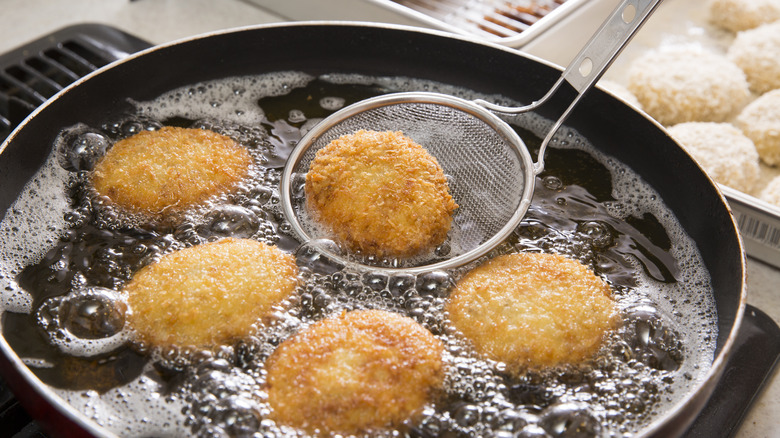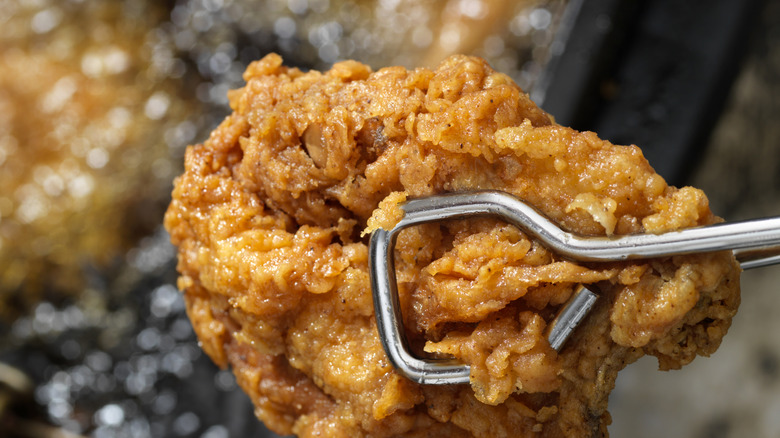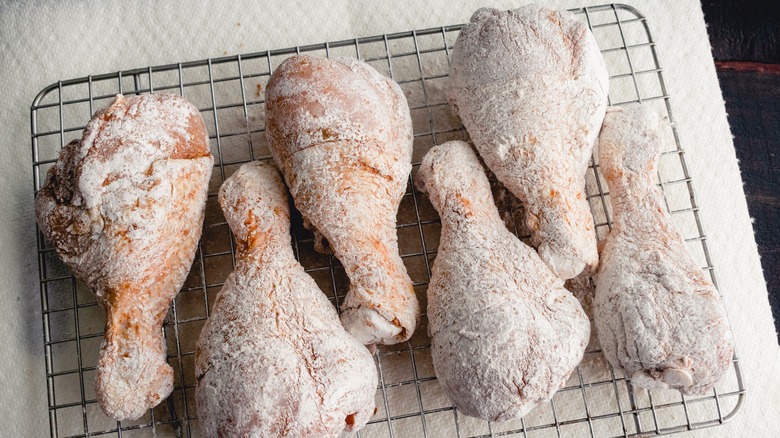The One Step You Shouldn't Skip When Frying Anything In Hot Oil
A bubbling pan of hot oil can be an intimidating sight in a kitchen, especially if you're new to the fried food game. Even if you're confident that you won't scald yourself or start a fire, there are a lot of things that can go wrong on the culinary side — and you can do a lot of work only to end up with soggy fried chicken or calamari with bare, breading-less patches.
Well, no more. There are a lot of mistakes you need to avoid when deep frying, like using the wrong oil or the wrong pan or trying to fry food straight out of the refrigerator. Still, once you've got your perfect setup and the battered bites are ready for the pan, there's an easy oil immersion technique to help ensure the food fries crisp with its coating intact. Put simply: Don't just drop the food into the hot oil. The best method is to dip the pieces into the hot oil and slowly move them around. This gives the coating time to solidify and the oil temperature time to regulate.
For the best fry, swirl it for a second
As the hot oil simmers and spatters, it's tempting to toss the pieces and step back (for the sake of your hands), but this technique is worth the up-close contact. Start by taking your breaded piece and allowing any excess batter to fall away. Tongs are often used for handling, but if you're frying something more delicate or the tongs are removing too much batter, a fork or a slotted spoon are good alternatives. Then, lower the food into the oil and gently swirl it around. You don't have to hold it the entire cooking time; just let the coating start to set.
The few seconds of setting accomplish two things: Heavier foods won't sink and stick as easily to the bottom of the pot when the batter has had time to firm up, and the frying pieces are less likely to stick to each other when they come into contact. Even so, you still shouldn't overcrowd your pan — give enough space for the pieces to cook evenly.
Overcrowding your pan not only affects the even cooking of your food but also the temperature of the oil. Each time you add a piece, the oil's temperature drops slightly, and a consistent oil temperature is crucial for achieving that crispy, golden-brown perfection. Cooking in oil that's too cold will lead to sogginess. Fortunately, this swirling secret comes in handy here, too — moving the piece around in the oil before you drop it helps the oil maintain its optimal temperature.
Better batters every time
Simple swirling will lead to a crispier and more intact breading for your fried foods, but there are other ways to help that coating stay in place and perfectly fry foods at home. Make sure that whatever you're frying (especially meat) is dry before you start coating it — if you don't pat it dry, the flour starts off watery, and the batter can easily slide off during frying. It also helps to give it a good pat after you've breaded it and before it goes in the fryer; this helps all the layers of breading stick. Cooling time on a wire rack in the refrigerator also helps the breading set and stay on.
Once that double pat and chilling time are done and you've dragged the pieces through the oil for a second, step back and leave them alone. You may need to flip them for even cooking, but too much moving around will cause the breading to come off. It also pays to rest your fried chicken or other fried foods before eating — after everything is finished, set the pieces on a wire rack to let excess oil come off, which helps the breading stay crispy, too.


